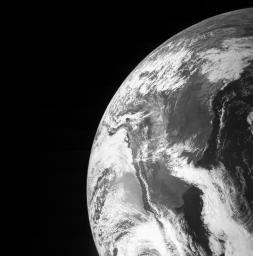
|
Earth from Juno
- Click the image above for a larger view
- Full-Res JPEG (1406 x 1420) (214.4 kB)
- Full-Res TIFF (1406 x 1420) (2.0 MB)
Caption:
On Oct. 9, NASA's Juno spacecraft flew past Earth, using our home planet's gravity to get the final boost it needed to reach Jupiter. The JunoCam instrument captured this monochrome view of Earth, and other instruments were tested to ensure they work as designed during a close planetary encounter.
The Juno spacecraft was launched from NASA's Kennedy Space Center in Florida on Aug. 5, 2011. Juno's rocket, the Atlas 551, was only capable of giving Juno enough energy or speed to reach the asteroid belt, at which point the Sun's gravity pulled Juno back toward the inner solar system. The Earth flyby gravity assist put Juno on course for arrival at Jupiter on July 4, 2016.
Background Info:
NASA's Jet Propulsion Laboratory, Pasadena, Calif., manages the Juno mission for the principal investigator, Scott Bolton, of Southwest Research Institute in San Antonio. The Juno mission is part of the New Frontiers Program managed at NASA's Marshall Space Flight Center in Huntsville, Ala. Lockheed Martin Space Systems, Denver, built the spacecraft. JPL is a division of the California Institute of Technology in Pasadena.
More information about Juno is online at http://www.nasa.gov/juno and http://missionjuno.swri.edu .
Cataloging Keywords:
| Name | Value | Additional Values |
|---|---|---|
| Target | Earth | Jupiter |
| System | ||
| Target Type | Planet | |
| Mission | Juno | |
| Instrument Host | Juno | |
| Host Type | Orbiter | |
| Instrument | JunoCam | |
| Detector | ||
| Extra Keywords | Asteroid, Grayscale, Visual | |
| Acquisition Date | ||
| Release Date | 2013-10-21 | |
| Date in Caption | 2011-08-05 | 2016-07-04 |
| Image Credit | NASA/JPL-Caltech/Malin Space Science Systems | |
| Source | photojournal.jpl.nasa.gov/catalog/PIA17542 | |
| Identifier | PIA17542 | |
